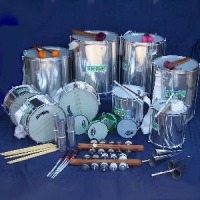Samba (dance) is a lively, rhythmical dance of Brazilian origin in 2/4 time danced under the Samba music. However, there are three steps to every bar, making the Samba feel like a 3/4 timed dance. Its origins include the Maxixe. There are two major streams of Samba dance that differ significantly: the Brazilian Samba and the Ballroom Samba. Brazilian Samba music has been danced in Brazil since its inception on the late 19th century. There are actually a set of dances, rather than a single dance, that define the Samba dancing scene in the country and none of them can be elected as the official one.
Many regional varieties of samba exist. As a folk dance, it was formerly important but its importance has diminished because of the popularity of the types of urban samba. In the southern-central areas, the folk samba is known as samba-lenco, samba, de roda, samba campineiro. The choreographic arrangement of the samba-lenco- dancers with a kerchief (lenco) in their hand- resembles the old batuque, in circular formation. With texts in forms of quatrains, the songs are performed in parallel thirds with snare drum and tambourine accompainment. The songs are usually in eight bars long, in duple meter with an anacrusis, and have a range of up to an octave, a descending motion with repeated notes, and isometric rhythm. The accompaniment exhibits typical Afro-Brazilian syncopation. Mario de Andrade observed that the samba is defined by its choreography rather than its musical structure. The latter shows an arched melody in duple meter, syncopated rhythmic figurations, strophic and variable textual forms, and the relative importance of textual improvisations.
Samba

